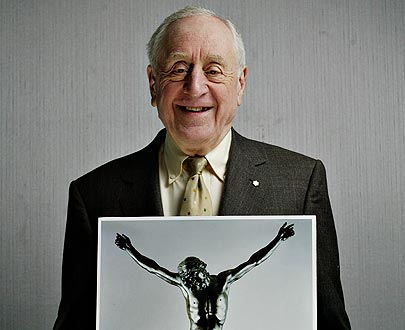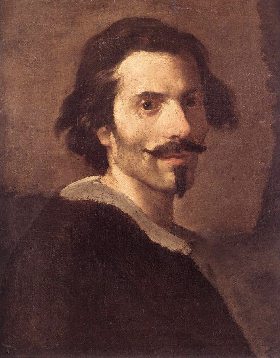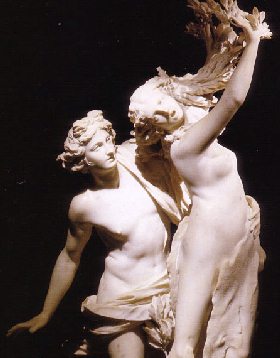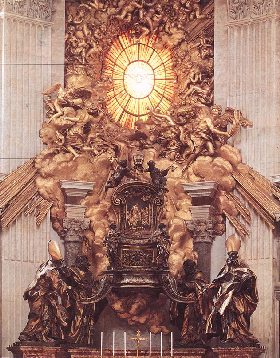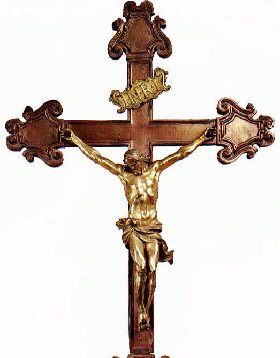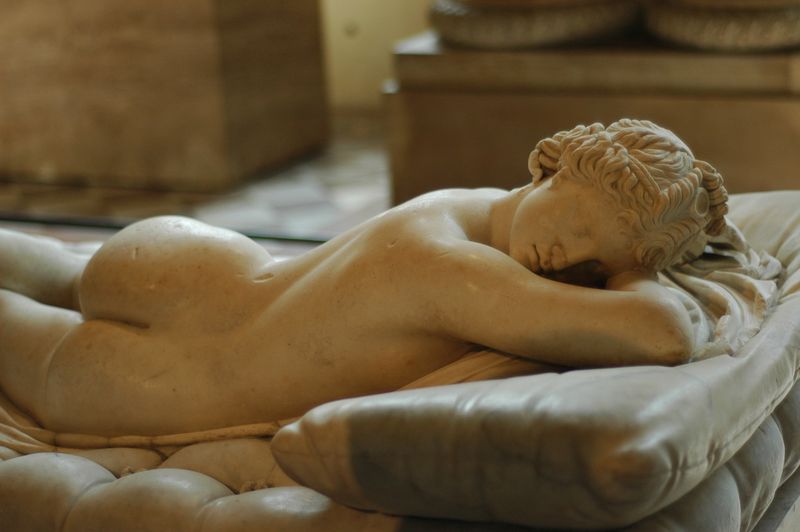| AGO gets $50M Bernini sculpture
Martin Knelman - January 11th 2007. After two years of intrigue, poker-faced negotiating and scholarly sleuthing, the Art Gallery of Ontario has landed a spectacular prize: a full-length, life-size crucifixion sculpture by the Italian Old Master Gian Lorenzo Bernini. This rare baroque treasure, called Corpus, is a gift of the Frum family. Cast in 1650, it is said to be worth $50 million in the current art market. Bernini, generally considered the greatest sculptor of the 17th century, created it for himself and held onto it for 25 years.
Toronto real estate developer Murray Frum donated Bernini’s 1650 sculpture
"It's so overwhelming, you just have to sit down after you see it," says Murray Frum, the Toronto developer, art collector and key AGO board member who bought the piece from a U.S. dealer after pursuing it for two years, then turned it over to the AGO as a gift from his family. "It's a thrilling moment for us," says Matthew Teitelbaum, CEO of the gallery. "And we've decided not to wait for our reopening after the Gehry transformation. Instead we will include it in a show we are doing this summer giving people a preview of what to expect from the new AGO." Bernini is known for his work at St. Peter's Basilica in Rome, especially an immense gilt-bronze baldachin (ornamental canopy) with twisted columns, created between 1624 and 1633, as well as Vatican papal tombs. But he's best loved for several great fountains in Rome. For a collector like Frum – who has already donated more than 80 pieces of primitive African sculpture to the AGO – the chase and conquest are part of the thrill. He was smitten as soon as he saw the piece because of its beauty, simplicity, emotion and scale (1.7 metres high). "I felt it didn't belong in a private home," Frum explained yesterday. (Not that Frum's architecturally notable house, with sumptuous gardens and art, is a typical home.) "To me, this piece belonged in a public institution." He let Teitelbaum know he was pursuing it. But the AGO had to wait for the game to play out. It involved complicated bargaining between Frum and a U.S. art dealer, as well as questions of authenticity, against the background of a red-hot international art market. And there was a special element of intrigue. The credentials of the piece had to be verified. Corpus had gone missing for a long time and was in the hands of a French collector who thought the artist unknown. After being recorded in the Perugia region of Italy circa 1790, it had been "lost" for over 100 years, until it surfaced in Venice in 1908. Later it fell into private hands in the U.S. But at that point it was misidentified as a work from the school of Giambologna. It was not until 2002 that it was recognized as a Bernini. And it took until 2005 for the provenance to be definitely and directly linked to Bernini. The AGO owns another Bernini, a smaller marble bust of Pope Gregory XV (1621) donated in 1997 by Joey and Toby Tanenbaum. According to Frum, Bernini made three Corpus sculptures. One belongs to Spain, part of the Spanish royal family's official collection. The other went missing during the Napoleonic wars. None of the three has ever been on public display before arriving in Toronto. "It's hard to believe it is made out of bronze," says Michael Parke-Taylor, the AGO's acting curator of European art, referring to the delicate finish. According to Teitelbaum, that reflects the goal of baroque artists to bring the divine into the realm of human experience. For the moment, the sculpture is in a huge storage crate in the AGO basement. When the AGO's renovation is completed two years from now, both Berninis are sure to be among the most talked about pieces in its permanent collection, along with the Peter Paul Rubens masterpiece Massacre of the Innocents (1611), donated by the late Ken Thomson. "After you have been a collector for a while," says Frum, "the challenge is to find pieces that truly excite you. This one did."
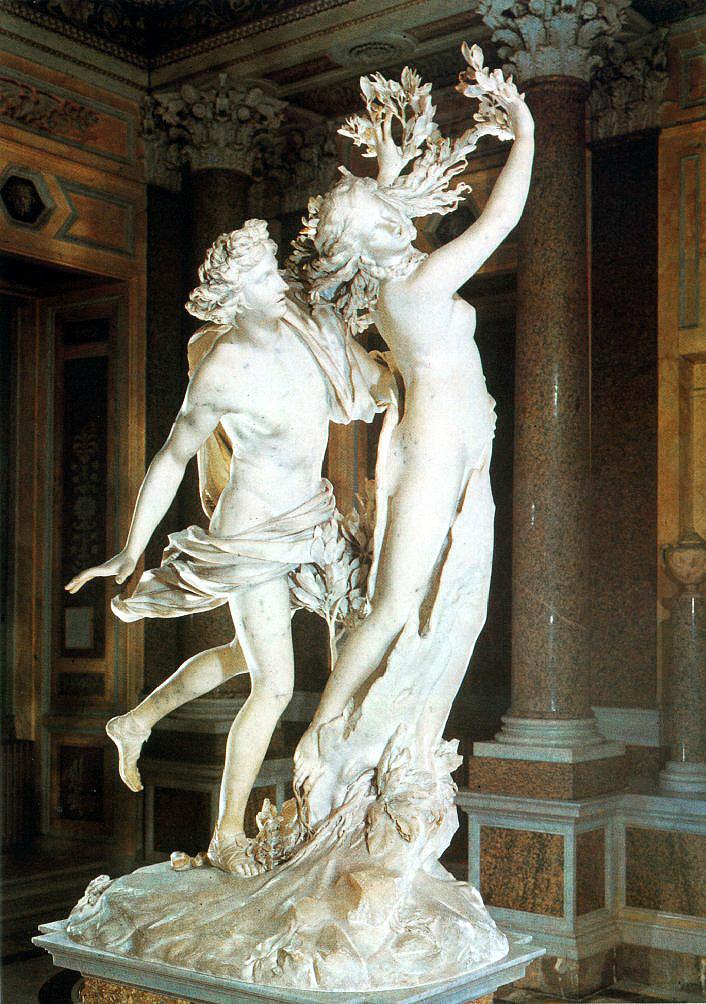
|
|||||
|
Bernini, Gianlorenzo (1598-1680):
Italian artist who was perhaps the greatest sculptor of the 17th century and an outstanding architect as well. Bernini created the Baroque style of sculpture and developed it to such an extent that other artists are of only minor importance in a discussion of that style. Early years Bernini's career began under his father, Pietro Bernini, a Florentine sculptor of some talent who ultimately moved to Rome. The young prodigy worked so diligently that he earned the praise of the painter Annibale Carracci and the patronage of Pope Paul V and soon established himself as a wholly independent sculptor. He was strongly influenced by his close study of the antique Greek and Roman marbles in the Vatican, and he also had an intimate knowledge of High Renaissance painting of the early 16th century. His study of Michelangelo is revealed in the St Sebastian (c. 1617), carved for Cardinal Maffeo Barberini, who was later Pope Urban VIII and Bernini's greatest patron. Bernini's early works attracted the attention of Cardinal Scipione Borghese, a member of the reigning papal family. Under his patronage, Bernini carved his first important life-size sculptural groups. The series shows Bernini's progression from the almost haphazard single view of Aeneas, Anchises and Ascanius Fleeing Troy (1619; Borghese Gallery, Rome) to strong frontality in Pluto and Proserpina (1621-22; Borghese Gallery) and then to the hallucinatory vision of Apollo and Daphne (1622-24; Borghese Gallery), which was intended to be viewed from one spot as if it were a relief. In his David (1623-24; Borghese Gallery), Bernini depicts the figure casting a stone at an unseen adversary. Several portrait busts that Bernini executed during this period, including that of Cardinal Robert Bellarmine (1623-24), show a new awareness of the relationship between head and body and display an ability to depict fleeting facial expressions with acute realism. These marble works show an unparalleled virtuosity in carving that obdurate material to achieve the delicate effects usually found only in bronze sculptures. Bernini's sensual awareness of the surface textures of skin and hair and his novel sense of shading broke with the tradition of Michelangelo and marked the emergence of a new period in the history of Western sculpture.
Patronage of Urban VIII With the pontificate of Urban VIII (1623-44), Bernini entered a period of enormous productivity and artistic development. Urban VIII urged his protégé to paint and to practice architecture. His first architectural work was the remodeled Church of Santa Bibiana in Rome. At the same time, Bernini was commissioned to build a symbolic structure over the tomb of St Peter in St Peter's Basilica in Rome. The result is the famous immense gilt-bronze baldachin executed between 1624 and 1633. Its twisted columns derive from the early Christian columns that had been used in the altar screen of Old St Peter's. Bernini's most original contribution to the final work is the upper framework of crowning volutes flanked by four angels that supports the orb and cross. The baldachin is perfectly proportioned to its setting, and one hardly realizes that it is as tall as a four-story building. Its lively outline moving upward to the triumphant crown, its dark colour heightened with burning gold, give it the character of a living organism. An unprecedented fusion of sculpture and architecture, the baldachin is the first truly Baroque monument. It ultimately formed the centre of a programmatic decoration designed by Bernini for the interior of St Peter's. Bernini next supervised the decoration of the four piers supporting the dome of St Peter's with colossal statues, though only one of the latter, St Longinus, was designed by him. He also made a series of portrait busts of Urban VIII, but the first bust to achieve the quality of his earlier portraits is that of his great patron, Cardinal Scipione Borghese (1632; Borghese Gallery). The cardinal is shown in the act of speaking and moving, and the action is caught at a moment that seems to reveal all the characteristic qualities of the subject. Bernini's architectural duties increased after the death of Carlo Maderno in 1629, when Bernini became architect of St Peter's and of the Palazzo Barberini. By this time he was not only executing works himself but also having to rely on assistance from others as the number of his commissions grew. He was successful in organizing his studio and planning his work so that sculptures and ornamentations produced by a team actually seem to be all of a piece. Bernini's work, then and always, was also shaped by his fervent Roman Catholicism (he attended mass every day and took communion twice a week). He would agree with the formulations of the Council of Trent (1545-63) that the purpose of religious art was to teach and inspire the faithful and to serve as propaganda for the Roman Catholic church. Religious art should always be intelligible and realistic, and, above all, it should serve as an emotional stimulus to piety. The development of Bernini's religious art was largely determined by his conscientious efforts to conform to those principles. Under Urban VIII Bernini began to produce new and different kinds of monuments - tombs and fountains. The tomb of Urban VIII (1628-47; St Peter's, Rome) shows the pope seated with his arm raised in a commanding gesture, while below him are two white marble figures representing the Virtues. Bernini also designed a revolutionary series of small tomb memorials, of which the most impressive is that of Maria Raggi (1643). But his fountains are his most obvious contribution to the city of Rome. His first, the Barcaccia in the Piazza di Spagna (1627-29), is analogous to the baldachin in its fusion of sculpture and architecture. The Triton Fountain in the Piazza Barberini (1642-43) is a dramatic transformation of a Roman architectonic fountain - the superposed basins of the traditional geometric piazza fountain appearing to have come alive. Four dolphins raise a huge shell supporting the sea god, who blows water upward out of a conch. Bernini's early architectural projects, however, were not invariably successful. In 1637 he began to erect campaniles, or bell towers, over the facade of St Peter's. But, in 1646, when their weight began to crack the building, they were pulled down, and Bernini was temporarily disgraced.
Patronage of Innocent X and Alexander VII Bernini's most spectacular public monuments date from the mid-1640s to the 1660s. The Fountain of the Four Rivers in Rome's Piazza Navona (1648-51) supports an ancient Egyptian obelisk over a hollowed-out rock, surmounted by four marble figures symbolizing four major rivers of the world. This fountain is one of his most spectacular works. The greatest single example of Bernini's mature art is the Cornaro Chapel in Santa Maria della Vittoria, in Rome, which completes the evolution begun early in his career. The chapel, commissioned by Cardinal Federigo Cornaro, is in a shallow transept in the small church. Its focal point is his sculpture of The Ecstasy of St Teresa (1645-52), a depiction of a mystical experience of the great Spanish Carmelite reformer Teresa of Ávila. In representing Teresa's vision, during which an angel pierced her heart with a fiery arrow of divine love, Bernini followed Teresa's own description of the event. The sculptured group, showing the transported saint swooning in the void, covered by cascading drapery, is revealed in celestial light within a niche over the altar, where the architectural and decorative elements are richly joined and articulated. At left and right, in spaces resembling opera boxes, numerous members of the Cornaro family are found in spirited postures of conversation, reading, or prayer. The Cornaro Chapel carries Bernini's ideal of a three-dimensional picture to its apex. The figures of St Teresa and the angel are sculptured in white marble, but the viewer cannot tell whether they are in the round or merely in high relief. The natural daylight that falls on the figures from a hidden source above and behind them is part of the group, as are the gilt rays behind. The Ecstasy of St Teresa is not sculpture in the conventional sense. Instead, it is a framed pictorial scene made up of sculpture, painting, and light that also includes the worshiper in a religious drama. In his later years, the growing desire to control the environments of his statuary led Bernini to concentrate more and more on architecture. Of the churches he designed after completing the Cornaro Chapel, the most impressive is that of Sant'Andrea al Quirinale (1658-70) in Rome, with its dramatic high altar, soaring dome, and unconventionally sited oval plan. But Bernini's greatest architectural achievement is the colonnade enclosing the piazza before St Peter's Basilica. The chief function of the large space was to hold the crowd that gathered for the papal benediction on Easter and other special occasions. Bernini planned a huge oval attached to the church by a trapezoidal forecourt - forms that he compared to the encircling arms of the mother church. The freestanding colonnades were a novel solution to the need for a penetrable enclosure. The piazza guides the visitor toward the church and counterbalances the overly wide facade of St Peter's. Bernini's oval encloses a space centred on the Vatican obelisk, which had been moved before the church by Sixtus V in 1586. Bernini moved an older fountain by Maderno into the long axis of the piazza and built a twin on the other side to make a scenographic whole. The analogies to Bernini's oval plan of Sant'Andrea al Quirinale are fascinating, as are the differences in meaning and function. Bernini's most spectacular religious decoration is the Throne of St Peter, or the Cathedra Petri (1657-66), a gilt-bronze cover for the medieval wooden throne (cathedra) of the pope. Bernini's task was not only to make a decorative cover for the chair but also to create a meaningful goal in the apse of St Peter's for the pilgrim's journey through the great church. The seat is seemingly supported by four imposing bronze figures representing theological doctors of the early church: Saints Ambrose, Athanasius, John Chrysostom, and Augustine. Above, a golden glory of angels on clouds and rays of light emanates from the Dove of the Holy Spirit, which is painted on an oval window. The cathedra was produced about the same time as the piazza, and the contrast between these two works shows Bernini's versatility. Both works were done for the Chigi pope, Alexander VII (1655-67), who was one of Bernini's greatest patrons. The tomb that Bernini designed for Alexander VII (1671-78; St Peter's) was largely executed by his pupils. In addition to his large works, Bernini continued to produce a few portrait busts. The first of these, of Francesco I d'Este, duke of Modena (1650-51; Este Gallery and Museum, Modena), culminates his revolution in portraiture. Much of the freedom and spontaneity of the bust of Cardinal Scipione Borghese is kept, but it is united with a heroic pomp and grandiose movement that portray the ideals of the Baroque age as much as the man. Trip to France Bernini went to Paris in 1665, in what was his only prolonged absence from Rome. The trip was made in response to invitations that for many years had been extended to him by King Louis XIV, and the purpose was the design of a new French royal residence. By this time, Bernini was so famous that crowds lined the streets of each city along the route to watch him pass. His initial reception in Paris was equally triumphant, but he soon offended his sensitive hosts by imperiously praising the art and architecture of Italy at the expense of that of France. His statements made him unpopular at the French court and were to some degree responsible for the rejection of his designs for the Louvre. The only relic of Bernini's visit to France is his great bust of Louis XIV, a linear, vertical, and stable portrait, in which the Sun King gazes out with godlike authority. The image set a standard for royal portraits that lasted 100 years.
Later years Bernini's late works in sculpture are inevitably overshadowed by his grandiose projects for St Peter's, but a few of them are of outstanding interest. For the Chigi Chapel in the Church of Santa Maria del Popolo in Rome, he carved two groups, Daniel in the Lions' Den and Habakkuk and the Angel (1655-61). These works show the beginnings of his late style: elongation of the body, expressive gesture, and simplified yet emphatic emotional expression. The same characteristics are already found in the figures supporting the Throne of St Peter and culminate in the moving Angels for the Sant'Angelo Bridge in Rome, which Bernini redecorated with the help of assistants between 1667 and 1671. Pope Clement IX (1667-69) so prized the Angels carved by Bernini that they were never set up on the bridge and are now in the church of Sant'Andrea delle Fratte in Rome. The redecorated Sant'Angelo Bridge leading across the Tiber forms an introduction to the Vatican, and Bernini's other works - the piazza, Scala Regia, and the baldachin and cathedra within St Peter's - form progressively more powerful expressions of papal power to support and inspire Roman Catholic pilgrims to the site. Bernini completed one more decoration in St Peter's in his last years: the altar of the Santissimo Sacramento Chapel (1673-74). The pliant, human adoration of the angels contrasts with the timeless architecture of the bronze tabernacle that they flank and typifies Bernini's late style. In his last years he seems to have found the inexorable laws of architecture a consoling antithesis to the transitory human state. Bernini's greatest late work is the simple Altieri Chapel in San Francesco a Ripa (c. 1674) in Rome. The relatively deep space above the altar reveals a statue representing the death of the Blessed Ludovica Albertoni. Bernini consciously separated architecture, sculpture, and painting for different roles, reversing the process that culminated in the Cornaro Chapel. In that sense, the Altieri Chapel is more traditional, a variation on his church interiors of the preceding years. Instead of filling the arched opening, the sculpted figure of Ludovica lies at the bottom of a large volume of space, and is illuminated by a heavenly light that plays on the drapery gathered over her recumbent figure. Her hands weakly clutching her breast make explicit her painful death. Bernini died at the age of 81, after having served eight popes, and when he died he was widely considered not only Europe's greatest artist but also one of its greatest men. He was the last of Italy's remarkable series of universal geniuses, and the Baroque style he helped create was the last Italian style to become an international standard. His death marked the end of Italy's artistic hegemony in Europe. The style he evolved was carried on for two more generations in various parts of Europe by the architects Mattia de' Rossi and Carlo Fontana in Rome, J.B. Fischer von Erlach in Austria, and the brothers Cosmas and Egid Quirin Asam in Bavaria, among others.
| |||||
Click Here to Join some Webrings
